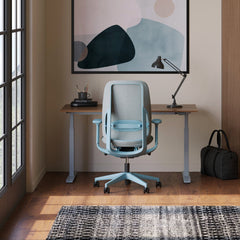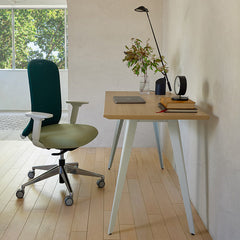Get 10% off your first order
Find the office furniture that’s designed to match your style, comfort, and needs perfectly. Subscribe
Room to Think: Designing an Efficient Workspace Without Overcrowding

Visit quiz page to see how we makes it easy to create an inspiring workplace


Work no longer fits into a single mold, and your workspace shouldn’t either. Modern professionals juggle multiple roles—creative thinking, meetings, analysis, and collaboration—all from the same table. To stay productive, your environment must flex with your workflow.
An adaptable workspace blends design, comfort, and functionality so that every task feels natural. Let’s explore how you can build a space that supports focus and movement without losing flow or style.
Rigid setups lead to repetitive work habits and fatigue. A flexible workspace allows your posture, mindset, and creativity to move freely.
Encourages active movement throughout the day.
Reduces muscle strain and tension.
Supports different working modes—deep focus, collaboration, rest.
Increases energy and creativity.
When design adapts to you, work feels lighter and more balanced.
Your desk defines how easily you switch between tasks. A compact yet adjustable table like the Small Standing Desk Nebraska keeps movement natural while maintaining balance between form and function.
|
Task |
Setup Tip |
Benefit |
|
Focus work |
Face away from distractions |
Improves concentration |
|
Creative sessions |
Angle toward natural light |
Boosts inspiration |
|
Meetings |
Clear surface space |
Encourages openness |
|
Writing or design |
Adjustable height |
Enhances comfort |
A great desk should always feel like it’s working with you, not against you.
Ergonomic furniture isn’t just about comfort—it’s about longevity. The right proportions and alignments allow you to move freely and maintain posture naturally.
A standing desk provides essential versatility for different work styles and physical needs.
Keep your monitor at eye level.
Align elbows at a 90-degree angle.
Alternate between sitting and standing every 45–60 minutes.
Keep your feet flat or supported by a rest.
When your body feels supported, your focus and productivity follow.
Every task demands a different kind of energy. Your layout should allow you to transition smoothly from focus-heavy work to creative discussions or planning.
|
Mode |
Space Requirement |
Example Setup |
|
Deep work |
Minimal setup |
Desk near a wall |
|
Collaboration |
Open layout |
Table in shared area |
|
Reflection |
Quiet, natural light |
Corner chair or window space |
|
Administrative |
Structured layout |
Organized desk zones |
Balancing focus and flexibility prevents burnout and keeps creativity alive.
Every piece of furniture should serve a purpose. An office desk with clean lines and hidden storage offers simplicity while maintaining function.
Keep high-use items within arm’s reach.
Leave open pathways to encourage movement.
Use vertical shelving for extra space.
Separate digital and physical work zones.
Efficiency is not about doing more—it’s about moving better.

According to research on workspace ergonomics, regular movement and proper setup reduce fatigue and increase concentration. Ergonomically sound spaces lead to higher energy levels and fewer posture-related injuries.
Adjustable furniture enhances productivity.
Good lighting reduces eye strain.
Proper desk height improves focus duration.
Alternating movement maintains alertness.
Ergonomics connects design to well-being—it’s science supporting creativity.
Modular furniture lets you adjust your workspace as projects evolve. A quad workstation provides structure for teamwork while maintaining flexibility for individual focus.
Combine moveable tables for group setups.
Use detachable surfaces for customization.
Add rolling storage to keep the floor clear.
Adjust lighting to fit various configurations.
A modular mindset keeps your workspace ready for any task.
Visual balance helps the mind process tasks clearly. A cluttered environment divides focus, while open arrangements promote calm and creativity.
Maintain symmetry across furniture placement.
Limit your color palette to two or three tones.
Keep horizontal lines clear and open.
Use texture to add depth instead of bulk.
Visual order supports both concentration and ease of movement.
Technology should enhance your space—not dominate it. Keep cords, screens, and devices organized so they serve your workflow seamlessly.
|
Tool |
Placement |
Effect |
|
Laptop stand |
Eye-level center |
Reduces neck strain |
|
Cord management |
Behind desk |
Keeps layout clean |
|
LED lighting |
Edge of workspace |
Adjusts for task type |
|
Wireless keyboard |
Floating zone |
Increases mobility |
Smart tech use enhances adaptability without adding clutter.
Not every workspace is solo. If you share your office with others, the design must balance shared needs with personal comfort.
Use neutral lighting for harmony.
Provide adjustable seating for all users.
Incorporate sound-absorbing panels for privacy.
Keep shared tools within equal reach.
Adaptable workspaces create environments where individuality and teamwork coexist effortlessly.
Lighting influences both focus and emotion. Cool tones energize analytical work, while warm tones encourage calm and creativity.
Combine direct and ambient sources.
Use task lights for precision work.
Let natural light guide your arrangement.
Adjust intensity for time of day and activity.
When light shifts with your workflow, your energy follows naturally.

A workspace built to adapt doesn’t need perfection—it needs flexibility. As your work changes, your setup should evolve to meet new challenges with ease.
Keep layouts open and changeable.
Choose ergonomic pieces with long-term adjustability.
Redefine zones as your tasks shift.
Refresh your setup regularly to maintain energy.
When design supports change, work feels effortless instead of restricted.
An adaptive workspace reflects a simple truth: the more fluid your environment, the smoother your day feels. From your table’s height to your layout’s flow, every element should respond to how you work—not force you to adjust to it.
Design for movement, not stillness.
Balance aesthetics with function.
Let furniture evolve with your goals.
Keep openness as your core principle.
When your space works with your rhythm, productivity stops feeling like effort—and becomes part of your everyday flow.

Room to Think: Designing an Efficient Workspace Without Overcrowding

Built to Support You: Why Ergonomic Tables Redefine Remote Work

The Art of Flow: Simple Table Arrangements for a Balanced Home Office
Get 10% off your first order
Find the office furniture that’s designed to match your style, comfort, and needs perfectly. Subscribe
Leave a comment